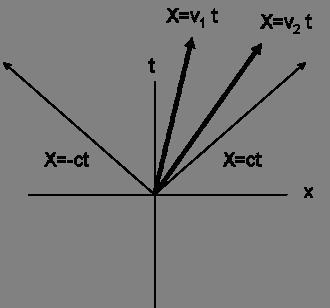 | ||
In a relativistic theory of physics, a Lorentz scalar is a scalar which is invariant under a Lorentz transformation. A Lorentz scalar may be generated from multiplication of vectors or tensors. While the components of vectors and tensors are in general altered by Lorentz transformations, scalars remain unchanged.
Contents
- The length of a position vector
- The length of a velocity vector
- The inner product of acceleration and velocity
- Energy rest mass 3 momentum and 3 speed from 4 momentum
- Measurement of the energy of a particle
- Measurement of the rest mass of the particle
- Measurement of the 3 momentum of the particle
- Measurement of the 3 speed of the particle
- More complicated scalars
- References
A Lorentz scalar is not a scalar in the mathematical sense, that is, invariant under any basis transformation. For example, the determinant of the matrix of basis vectors is a number that is invariant under Lorentz transformations, but it is not invariant under any basis transformation.
The length of a position vector
In special relativity the location of a particle in 4-dimensional spacetime is given by
where
The "length" of the vector is a Lorentz scalar and is given by
where
This is a time-like metric.
Often the alternate signature of the Minkowski metric is used in which the signs of the ones are reversed.
This is a space-like metric.
In the Minkowski metric the space-like interval
We use the space-like Minkowski metric in the rest of this article.
The length of a velocity vector
The velocity in spacetime is defined as
where
The magnitude of the 4-velocity is a Lorentz scalar,
Hence, c is a Lorentz scalar.
The inner product of acceleration and velocity
The 4-acceleration is given by
The 4-acceleration is always perpendicular to the 4-velocity
Therefore, we can regard acceleration in spacetime as simply a rotation of the 4-velocity. The inner product of the acceleration and the velocity is a Lorentz scalar and is zero. This rotation is simply an expression of energy conservation:
where
Energy, rest mass, 3-momentum, and 3-speed from 4-momentum
The 4-momentum of a particle is
where
is the energy of the particle.
Measurement of the energy of a particle
Consider a second particle with 4-velocity
where the subscript 1 indicates the first particle.
Since the relationship is true in the rest frame of the second particle, it is true in any reference frame.
in any inertial reference frame, where
Measurement of the rest mass of the particle
In the rest frame of the particle the inner product of the momentum is
Therefore, the rest mass (m) is a Lorentz scalar. The relationship remains true independent of the frame in which the inner product is calculated. In many cases the rest mass is written as
Measurement of the 3-momentum of the particle
Note that
The square of the magnitude of the 3-momentum of the particle as measured in the frame of the second particle is a Lorentz scalar.
Measurement of the 3-speed of the particle
The 3-speed, in the frame of the second particle, can be constructed from two Lorentz scalars
More complicated scalars
Scalars may also be constructed from the tensors and vectors, from the contraction of tensors, or combinations of contractions of tensors and vectors.
